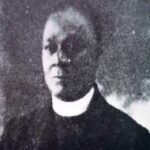MIKAEL, RAS
- 4 Min Read
Ras Mikael Ali Abba Bula of Ethiopia (circa 1850-September 8, 1918), or Mohammed Ali, was one of the key provincial governors appointed by Emperor Menilek II, and was the father of Lej Iyasu Mikael.

PHOTO CAPTION: Ras Mikael Ali Abba Bula SOURCE: EA Library
In the early 1870s, Abba Watto supported Emperor Yohannes IV [ruled 1872-1889] against Menilek, who was scheming to overthrow the emperor. To gain control over Wallo, the strategic buffer region between Shawa and Tegre, Menilek attacked and defeated Abba Watto in 1876 and appointed Mohamed Ali to rule Wallo.
When in 1878 Menilek lost military power, Mohamed rebelled and went over to Emperor Yohannes. Menilek and Yohannes came to an agreement in 1878, however, and Mohamed Ali retained his position in Wallo, renounced Islam, was baptised as Mikael, and raised to the rank of Ras. In February 1886, he was made governor of Wallo.
On Yohannes’ death in 1889, Menilek proclaimed himself emperor under the terms of the succession agreement of 1882, and Ras Mikael, realising Menilek’s political and military strength, quickly recognised his accession and participated in his coronation on November 3, 1889.
Between 1889 and 1891, Menilek tested Mikael, using him to crush rebellious chiefs, one of whom was Ras Mangasha Yohannes, the son and heir of Yohannes. By 1892, Menilek was sufficiently convinced of Mikael’s sincerity to allow him to marry is daughter, Wayzaro Shawaraggad Menilek, thus obtaining an ally against Ras Wale of Yaju.
Having one of the larger provincial armies of Ethiopia, Mikael joined in the conquest of Walamo in 1894, and commanded a large Ethiopian force against the Italians at the battle of Adwa on March 1, 1896. After the Italian defeat at Adwa, Mikael kept control of the Afar of Awssa, and in 1898, after Mangasha’a last rebellion, he helped Ras Makonnen to pacify Tegre.
When Makonnen died unexpectedly in 1905, Empress Taytu Betul, whose family had some claim to Solomonic blood, tried to obtain the succession for her brother, Ras Wale, or his son, Ras Gugsa Wale, who had married Menilek’s daughter Zawditu. Since both men were Tegreans, their nomination would have been improper from the Shawan point of view.
Menilek therefore gave the succession to Lej Iyasu Mikael, his grandson by Ras Mikael, and to his daughter. After 1910, however, when Menilek fell ill and the regency was not functioning well, Empress Taytu became the ruler of Ethiopia. But on March 21, 1910, backed by Mikael’s army, and their own resources, the more powerful Shawan leaders staged a successful coup against her. When Ras Tassama Nadaw, Menilek’s appointee as regent, died suddenly in 1911, Lej Iyasu, supported by his father, became Emperor.
Much controversy surrounds Lej Iyasu’s five-year reign. By the middle of 1916, Shawan politicians felt that Lej Iyasu’s activities spelled disaster for Menilek’s state and its established religion. A coup overthrew him, and on September 25, 1916, Menilek’s daughter Zawditu was proclaimed empress of Ethiopia.
Mikael had been raised to the rank of negus (king) by his son on May 31, 1914, and with Iyasu’s deposition, he realised he would lose power. As Iyasu had not been captured by the forces sent after him, Mikael decided to mobilise his army, march upon Addis Ababa, defeat the Shawans, and restore his son to the throne.
At first he was successful, but on October 22, 1916, at Sagale, 48 mi (80km) north of Addis Ababa, he was defeated by government forces led by Fitawrari Habte Giyorgis, Ras Kassa Haylu, and Ras Tafari, later to become Emperor Haile Selassie. Negus Mikael was captured and marched in chains at the victory parade in Addis Ababa on November 3, 1916. He was convicted of treason, and died in captivity at Dendi on September 8, 1918.
HAROLD G. MARCUS




